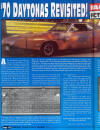
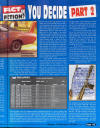
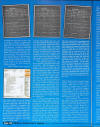
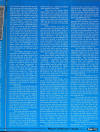
No part of this article may be copied or reproduced without written permission of the author.
A shorter version of this article appeared in the June 2004 issue of Mopar Collector's Guide.
There was a time when cars were about one thing - being cool. Car manufacturers knew this and much like a young kid in high school who'd fix up his ride a little better than his best friend's, car manufacturers devised ways to make their cars "cooler" than their competition. Add some options, invent some new gadget that opened a door in the hood, design an eye-opening color, and the public would buy their car.
I've always loved wing cars. I had an opportunity to buy a '69 Hemi Daytona for a very good price back in 1988, and even though I could have scraped together the money somehow, I didn't. And as luck would have it, the car went to another buyer instead of me.
Soon after that, a friend of mine called me up, begging to borrow some money. He said he had found a super cool car, but would not tell me what it was. I loaned him the money and a short while later, he showed me a pile of parts in his garage that most any Mopar nut would salivate over. 440 engine, Six-Pack intake & carbs, transmission, doors, seats, dash assembly with VIN, fendertag. Almost everything one would want, short of an actual shell of a car. As the story goes, the car was wrecked HARD in the back end. Fixing this kind of damage would entail either hundreds of hours on a frame rack, or "back-halfing" the car with a parts car, or just rebodying the car entirely. All 3 repair methods have their benefits and their drawbacks, but if you're on a shoe-string budget, you make due with what you can.
Time passed and I had moved away, loosing touch with my friend and "the red car". A few years later, we reconnected, thanks in part to the wonders of the Internet & email. I was amazed to hear the tail of some recent discoveries he had made, the biggest one being that the red car had once been a near identical twin to a purple Daytona we had seen years earlier in a Mopar magazine. Having actually seen the purple car myself in 1992, I had a vague idea of what the red car was purported to be. Over the next few years, talk of the red car came and went on some of the Mopar chat boards, and even though many people said "they never made a 1970 Daytona", I knew in my own mind that my friend had the remains of one and he was slowly tracking it's history. "Someday", I thought, "the entire world will stunned to see this car is real".
More time passes and talk of '70 Daytona's comes & goes once again. My friend told me he was having some "financial troubles" and offered to sell me the red car, and this time I didn't hesitate. I was up to the challenge of repairing a totaled car, or if the repairs would require more drastic measures, the idea of having a non-numbers matching clone didn't upset me either. If the car had been a Daytona, it would be one again. And if the car was nothing more than a Charger, then so be it. The price wasn't a steal by any measure, but somehow it wasn't about money; it was about having the coolest car possible.
After we struck a deal, it took several trips, lots of phone calls, and a few packages in the mail to get the majority of the parts that had been on the original inventory for the red car. I looked everything over and was quite happy, even though some of my friends raised some doubts. Again I looked over what I had and called & E-mailed my friend in an effort to track down exactly what this car was. My biggest concern was the sun roof. If the car really was a Charger, then it shouldn't have one. If it really was a twin to the purple car, then according to the documents I had, it should have one. From a body shop perspective, this is one of those decisions that is very tough to go back on: Do I or don't I cut a huge hole in the roof?? I didn't want to make the wrong decision in haste, and truthfully, this was the only reason why I had to know for certain what this car was. I decided to try to document the actual documents themselves, but I never thought what I would find would read like a story line for CSI.
Looking at the documents that came with the car, there is a fendertag, one broadcast sheet that is about 90% complete, another broadcast sheet that is 100% complete, a third sheet that is just a small edge, a window sticker, a dealer add-on sticker, and a "warranty transfer request". Also included were 3 microfiche printouts of broadcast sheets (one for each of the '70 Daytonas) and 3 microfiche printouts of shipping manifests from the St. Louis plant (again one for each of the '70 Daytonas). Looking at each document and the data they show, they seem to support the rumors that have been floating around since the late '70s: Chrysler had built 3 prototype 1970 Daytonas in an effort to find a way of producing them economically.
Looking at each one individually, I see:
It all looks very kosher even with all the nay-sayers echoing in my ears. But I had to know for certain.
After contacting Jerry Junneman (the current owner of the purple car) and Bill Schwartz (RM Cars Online), they put me in touch with Randy Holden at Mopar Collector's Guide. Randy and I both agreed that I needed to have these docs looked at by someone with more knowledge of wing cars and he suggested Jim Radke, another person I had only seen but once since the late '80s. I booked a flight and rental car and ended up spending 5 hours at Jim's house. We poured through the docs and compared them to some that he had. We also looked through old photos, including several of the purple car when it had the mini front bumpers and when it was painted red. I asked Jim "Is that THE red car?" and he said "Nope, that's Jerry's car". "Are you SURE??" "Yes" I was hard pressed to believe that the purple car was ever red, especially considering that this trip was all about a red car to begin with. Even though we didn't come to any earth shattering findings, I left Jim's house feeling a small sense of accomplishment. When I got home, I made a quick phone call to Jerry and he confirmed that the purple car had once been painted red.
I sent Jim photocopies of my docs so he could look at them and show them to other people he knew. Jim told me to "check the spacing" of the fendertag because one of his contacts said it looked wrong. So that night I sat down with a dial caliper and a 8x magnifying glass, and compared it to others from St. Louis that I had saved (2 from 1970, 2 from 1971, 1 from 1972 and 1 from 1974).
 Looking at the red car tag, I found several differences:
Looking at the red car tag, I found several differences:
Needless to say, I felt disheartened. Jim later remarks about the codes themselves:
"I did however notice something right away on all of the '70 Charger tags I have. They all have an embossed inspection "stamp" on them. Even with a small number punched through the metal too as an inspection mark.
Then I got to looking at a couple of SE tags I pulled. Definite flaws in the red car's tag. None have N41. You can find a N41 number on Detroit built cars in 1970, but not St. Louis. They can change from plant to plant.
The red car's tag is also missing the M31 code which all SEs have. Humm..... missing? I find no code on the tags either for tinted glass. I know some of those cars had tinted glass in them. Not sure now if the power window code is used on St. Louis cars in 1970. As I said, I haven't gone through all the '70 Charger tags yet. It is also missing the N95 code which they should all have."
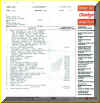 Jim told me to look at the window sticker. His contact had pointed out
that the ampersand symbol was incorrect. I took it to a friend of mine, Paul
Todd, who was a Chrysler mechanic & service manager for 30 years. He looked at the
symbol and immediately exclaimed "That's incorrect!". The correct
symbol is more flowing and fancy looking. We spent an hour and looked over the
rest of the window sticker. We found:
Jim told me to look at the window sticker. His contact had pointed out
that the ampersand symbol was incorrect. I took it to a friend of mine, Paul
Todd, who was a Chrysler mechanic & service manager for 30 years. He looked at the
symbol and immediately exclaimed "That's incorrect!". The correct
symbol is more flowing and fancy looking. We spent an hour and looked over the
rest of the window sticker. We found:
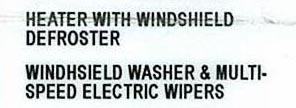
Meanwhile, Randy Holden, Galen Govier, and Jim Radke are looking at the broadcast sheets. Jim wrote to me: "I did get an answer on the 7005 number. That's the "correct" steering column setup for a power steering column with ignition light wiring. So the red car's sheet is "right," and the other two are wrong." Jim also noticed that there was no mention of "N95, Evaporative Emissions Control System", something a car sold in California would have to have in 1970. "The broadcast sheet shows that the car came with hubcaps. Okay, fine. So did the blue car if we are to believe it. But even if we are supposed to believe it then it should be listed on the window sticker with a price. That wasn't part of a SE package. 'Cept there's one problem. A '70 Charger RT/SE (& SE) never came with the W13 style hubcap. The only full face hubcaps that you could get on a SE Charger model were wire wheel covers." Jim also mentions the print time on the broadcast sheets: "Oh, in closing Galen did say that it would almost be physically impossible for all of these sheets to have the same printout time on them." I'd have to agree with this, considering all of the microfiche prints came from printer A while the hard copy (#2) came from printer C. Everyone had also noticed that the micro-fiche broadcast sheet for the purple car showed the code for black vinyl roof, while the actual fendertag on the car showed purple painted roof. Hmmmmm.....
 I sat down one night and compared the red car's broadcast sheet #2 to another broadcast
sheet that I have. The
VIN on this sheet is XS29U0G120050 and it is an early style sheet (2 color).
What I found was even more eye-opening:
I sat down one night and compared the red car's broadcast sheet #2 to another broadcast
sheet that I have. The
VIN on this sheet is XS29U0G120050 and it is an early style sheet (2 color).
What I found was even more eye-opening:
Throughout all this, I kept thinking that my friend might have been tricked himself by whoever he had gotten the documents from over the years. But I soon found more errors that made me question even this possibility.
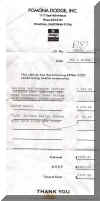 The next document to look at was the dealer add-on sheet. Jim wrote "Reading the separate invoice again is sort of amusing.
I mean why describe the rallye wheels as "T/A?" Afterall, the
Challenger T/A was a mid-year car. The 15" rallyes were on the '70
muscle Scat Pack cars long before the T/A. T/A sounds to me more like
later vintage ('80s) lingo. Or am I off base here?" Jim also
remarked about the Daytona fender scoops: "Why doesn't the separate invoice
mention those in the 'include?' "
The next document to look at was the dealer add-on sheet. Jim wrote "Reading the separate invoice again is sort of amusing.
I mean why describe the rallye wheels as "T/A?" Afterall, the
Challenger T/A was a mid-year car. The 15" rallyes were on the '70
muscle Scat Pack cars long before the T/A. T/A sounds to me more like
later vintage ('80s) lingo. Or am I off base here?" Jim also
remarked about the Daytona fender scoops: "Why doesn't the separate invoice
mention those in the 'include?' "
I myself think it's implausible that a radio upgrade would cost more than a tire & wheel upgrade, even if the price of the original wheels & tires was deducted (core charge?). But then again, what do I know...?
Looking at the type writer font itself, Jim remarked "Another thing about the separate invoice. Somehow the dollar sign ($) just looks too "modern" for me on a vintage 1970 typewriter. Manual or electric." I dug out my copies of old newsletters that I had saved from the late 80's & early 90's, back in the day when my friend was club president and I was (for a while) co-vice-president. Guess what? The March '88 and December '88 issues both have the same symbol -- a single bar that is longer on the bottom then on the top and does NOT go all the way through the symbol. All other issues in '88 have a symbol with a double bar that does go all the way through. The March '89 issue has a single bar that goes all the way through.
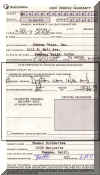 The last piece of documentation to
examine was the warranty card. The typing on it is harder, as evidenced by the number of letters that split
through the paper. The font is different then the font on the dealer add-on sheet.
The number "2" has a little bit of red showing on the bottom edge, but
I've seen this before on typewriters that have a multi-colored ribbon (black,
red, and white; all on one ribbon). At first, the writing didn't yield any
clues, until I looked at the manila envelope that the sheet was kept in.
The sheet is hand dated 1971, but the form itself is date coded for 1984. I looked at the word "warranty" in the middle of the sheet, which is
abbreviated to "wry", and then I saw the writing on the manila
envelope that the sheet was in. The envelope was labeled by my friend in red
felt-tip marker. Compare the "w" and the
"y" to those on the warranty card......
The last piece of documentation to
examine was the warranty card. The typing on it is harder, as evidenced by the number of letters that split
through the paper. The font is different then the font on the dealer add-on sheet.
The number "2" has a little bit of red showing on the bottom edge, but
I've seen this before on typewriters that have a multi-colored ribbon (black,
red, and white; all on one ribbon). At first, the writing didn't yield any
clues, until I looked at the manila envelope that the sheet was kept in.
The sheet is hand dated 1971, but the form itself is date coded for 1984. I looked at the word "warranty" in the middle of the sheet, which is
abbreviated to "wry", and then I saw the writing on the manila
envelope that the sheet was in. The envelope was labeled by my friend in red
felt-tip marker. Compare the "w" and the
"y" to those on the warranty card......

So here at long last is the red car's documentation. Fact or fraud? .... I think you know my answer.
One more thing - My "friend" has offered 3 times to buy the car back, on payments, and I've turned him down each time. It's not about the money, it's about trust & friendship. He also swears that he faked none of the documents listed about.
I invite everyone reading this to examine the documents and prove my findings wrong, if you can. If you happen to be in Northern California and would like to look at them first hand, send me an email and I'll gladly show them to you.
I DID NOT ASK FOR, NOR DID I RECEIVE, ANY COMPENSATION from Mopar Collector's Guide for my story. If you've enjoyed this article and feel that the TRUTH needs to be kept alive, please send a donation ($1 or more) through www.paypal.com to hemibill@gmail.com . Thank you!!
No part of this article may be copied or reproduced without written permission of the author.
But wait! The story continues....... CLICK HERE